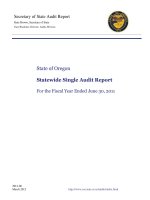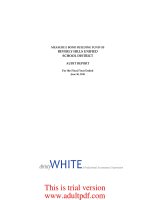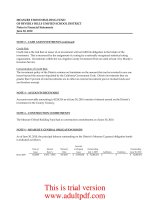REPORT NO. 2011-129 MARCH 2011 POLK STATE COLLEGE Financial Audit For the Fiscal Year Ended June 30, 2010-part4 docx
Bạn đang xem bản rút gọn của tài liệu. Xem và tải ngay bản đầy đủ của tài liệu tại đây (273.29 KB, 9 trang )
MARCH 2011 REPORT NO. 2011-129
POLK STATE COLLEGE
A COMPONENT UNIT OF THE STATE OF FLORIDA
NOTES TO FINANCIAL STATEMENTS (C
ONTINUED)
J
UNE 30, 2010
27
years ended June 30, 2008, June 30, 2009, and June 30, 2010, totaled $1,109,425, $1,148,174, and $1,170,072,
respectively, which were equal to the required contributions for each fiscal year.
As provided in Section 121.4501, Florida Statutes, eligible FRS members may elect to participate in the
PEORP in lieu of the FRS defined-benefit plan. College employees already participating in the State College
System Optional Retirement Program or the DROP are not eligible to participate in this program.
Employer contributions are defined by law, but the ultimate benefit depends in part on the performance of
investment funds. The PEORP is funded by employer contributions that are based on salary and
membership class (Regular Class, Senior Management Service Class, etc.). Contributions are directed to
individual member accounts, and the individual members allocate contributions and account balances among
various approved investment choices. Employees in PEORP vest at one year of service. There were
94 College participants during the 2009-10 fiscal year. Required contributions made to the PEORP totaled
$377,119.
Financial statements and other supplementary information of the FRS are included in the State’s
Comprehensive Annual Financial Report, which is available from the Florida Department of Financial
Services. An annual report on the FRS, which includes its financial statements, required supplementary
information, actuarial report, and other relevant information, is available from the Florida Department of
Management Services, Division of Retirement.
State College System Optional Retirement Program
. Section 1012.875, Florida Statutes, provides for an
Optional Retirement Program (Program) for eligible college instructors and administrators. The Program is
designed to aid colleges in recruiting employees by offering more portability to employees not expected to
remain in the FRS for six or more years.
The Program is a defined-contribution plan, which provides full and immediate vesting of all contributions
submitted to the participating companies on behalf of the participant. Employees in eligible positions can
make an irrevocable election to participate in the Program, rather than the FRS, and purchase retirement and
death benefits through contracts provided by certain insurance carriers. The employing college contributes,
on behalf of the participant, 10.43 percent of the participant’s salary, less a small amount used to cover
administrative costs. The remaining contribution is invested in the company or companies selected by the
participant to create a fund for the purchase of annuities at retirement. The participant may contribute, by
payroll deduction, an amount not to exceed the percentage contributed by the college to the participant’s
annuity account.
There were 36 College participants during the 2009-10 fiscal year. Required employer contributions made to
the Program totaled $238,362.
11. CONSTRUCTION COMMITMENTS
The College’s construction commitments at June 30, 2010, are as follows:
This is trial version
www.adultpdf.com
MARCH 2011 REPORT NO. 2011-129
POLK STATE COLLEGE
A COMPONENT UNIT OF THE STATE OF FLORIDA
NOTES TO FINANCIAL STATEMENTS (C
ONTINUED)
J
UNE 30, 2010
28
Project Description Total Completed Balance
Committed to Date Committed
Lakeland Campus Student Center 4,217,814$ 2,699,733$ 1,518,081$
Chain of Lakes High
School Building 301,849 40,141 261,708
Winter Haven Campus Greenhouse 8,400 5,836 2,564
Total
4,528,063$ 2,745,710$ 1,782,353$
12. RISK MANAGEMENT PROGRAMS
The College is exposed to various risks of loss related to torts; theft of, damage to, and destruction of assets;
errors and omissions; injuries to employees; and natural disasters. The College provided coverage for these
risks primarily through the Florida College System Risk Management Consortium (Consortium), which was
created under authority of Section 1001.64(27), Florida Statutes, by the boards of trustees of the Florida
public colleges for the purpose of joining a cooperative effort to develop, implement, and participate in a
coordinated Statewide College risk management program. The Consortium is self-sustaining through
member assessments (premiums) and is reinsured through commercial companies for claims in excess of
specified amounts. Reinsurance from commercial companies provided excess coverage of up to
$175 million through February 28, 2010, and up to $150 million starting March 1, 2010. Insurance coverage
obtained through the Consortium included health and hospitalization, life, dental, fire and extended
property, general and automobile liability, workers’ compensation, and other liability coverage. Settled
claims resulting from these risks have not exceeded coverage in any of the past three fiscal years.
Team sport accident coverage, group long-term disability coverage, and bonding of the members of the
Board of Trustees are being provided through purchased commercial insurance with minimum deductibles
for each line of coverage. Settled claims resulting from these risks have not exceeded commercial coverage
in any of the past three fiscal years.
13. SCHEDULE OF STATE REVENUE SOURCES
Revenue from State sources for current operations is primarily from the College Program Fund administered
by the Florida Department of Education under the provisions of Section 1011.81, Florida Statutes. In
accordance with Section 1011.84, Florida Statutes, the Legislature determines each college’s apportionment
considering the following components: base budget, which includes the State appropriation to the College
Program Fund in the current year plus the related student tuition and fees assigned in the current General
Appropriations Act; the cost-to-continue allocation, which consists of incremental changes to the base
budget, including salaries, price levels, and other related costs; enrollment workload adjustments; operation
costs of new facilities adjustments; and new and improved program enhancements, which are determined by
the Legislature. Student fees in the base budget plus student fee revenues generated by increases in fee rates
are deducted from the sum of these components to determine the net annual State apportionment to each
college.
This is trial version
www.adultpdf.com
MARCH 2011 REPORT NO. 2011-129
POLK STATE COLLEGE
A COMPONENT UNIT OF THE STATE OF FLORIDA
NOTES TO FINANCIAL STATEMENTS (C
ONTINUED)
J
UNE 30, 2010
29
The State allocates gross receipts taxes, generally known as Public Education Capital Outlay money, to the
College on an annual basis. The College is authorized to receive and expend these resources only upon
applying for and receiving an encumbrance authorization from the Florida Department of Education.
The following is a summary of State revenue sources and amounts:
Source Amount
College Program Fund 15,229,389$
Gross Receipts Tax (Public Education Capital Outlay) 2,513,973
2,148,571
Bright Futures Scholarship Program 1,703,161
Restricted Contracts and Grants 967,526
Florida Student Assistance Grants 446,804
Motor Vehicle License Tax (Capital Outlay and Debt Service) 266,738
Other State Sources 68,566
Total
23,344,728$
Education Enhancement Trust Fund (Lottery)
14. FUNCTIONAL DISTRIBUTION OF OPERATING EXPENSES
The functional classification of an operating expense (instruction, academic support, etc.) is assigned to a
department based on the nature of the activity, which represents the material portion of the activity
attributable to the department. For example, activities of an academic department for which the primary
departmental function is instruction may include some activities other than direct instruction such as public
service. However, when the primary mission of the department consists of instructional program elements,
all expenses of the department are reported under the instruction classification. The operating expenses on
the statement of revenues, expenses, and changes in net assets are presented by natural classifications. The
following are those same expenses presented in functional classifications as recommended by NACUBO:
Functional Classification Amount
Instruction 19,032,469$
Public Services 125,705
Academic Support 6,759,180
Student Services 4,608,960
Institutional Support 7,589,949
Operation and Maintenance of Plant 10,077,757
Scholarships and Fellowships 9,979,632
Depreciation 3,094,244
Auxiliary Enterprises 214,776
Total Operating Expenses
61,482,672$
15. CURRENT UNRESTRICTED FUNDS
The Southern Association of Colleges and Schools, Commission on Colleges, which establishes the
accreditation requirements for institutions of higher education, requires a disclosure of the financial position
of unrestricted net assets, exclusive of plant assets and plant-related debt, which represents the change in
This is trial version
www.adultpdf.com
MARCH 2011 REPORT NO. 2011-129
POLK STATE COLLEGE
A COMPONENT UNIT OF THE STATE OF FLORIDA
NOTES TO FINANCIAL STATEMENTS (C
ONTINUED)
J
UNE 30, 2010
30
unrestricted net assets. To meet this requirement, statements of net assets and revenues, expenses, and
changes in net assets for the current unrestricted funds are presented, as follows:
ASSETS
Current Assets:
Cash and Cash Equivalents 6,127,841$
Accounts Receivable, Net 889,160
Due from Other Governmental Agencies 536,667
TOTAL ASSETS
7,553,668$
LIABILITIES
Current Liabilities:
Accounts Payable 214,475$
Salary and Payroll Taxes Payable 1,931,009
Due to Other Governmental Agencies 224,731
Deferred Revenue 260,654
Compensated Absences Payable 12,858
Total Current Liabilities
2,643,727
Noncurrent Liabilities:
Compensated Absences Payable 2,115,989
Other Postemployment Benefits Payable 93,463
TOTAL LIABILITIES
4,853,179
TOTAL NET ASSETS
2,700,489
TOTAL LIABILITIES AND NET ASSETS
7,553,668$
Statement of Current Unrestricted Funds Net Assets
This is trial version
www.adultpdf.com
MARCH 2011 REPORT NO. 2011-129
POLK STATE COLLEGE
A COMPONENT UNIT OF THE STATE OF FLORIDA
NOTES TO FINANCIAL STATEMENTS (C
ONTINUED)
J
UNE 30, 2010
31
REVENUES
Operating Revenues:
Student Tuition and Fees, Net of Scholarship
Allowances of $6,878,448 7,952,523$
State and Local Grants and Contracts 458,500
Nongovernmental Grants and Contracts 873,139
Sales and Services of Educational Departments 66,155
Auxiliary Enterprises 454,746
Other Operating Revenues 287,663
Total Operating Revenues
10,092,726
EXPENSES
Operating Expenses:
Personnel Services 25,455,850
Utilities and Communications 2,237,980
Contractual Services 4,093,435
Other Services and Expenses 2,524,947
Materials and Supplies 1,894,781
Total Operating Expenses
36,206,993
Operating Loss
(26,114,267)
NONOPERATING REVENUES
State Appropriations 17,377,860
Gifts and Grants 1,535,568
Investment Income 50,181
Other Nonoperating Revenues 8,729
Net Nonoperating Revenues
18,972,338
Loss Before Other Revenues,
Expenses, Gains, or Losses
(7,141,929)
Transfers from Other Funds 6,774,445
Decrease in Net Assets
(367,484)
Net Assets, Beginning of Year 3,067,973
Net Assets, End of Year
2,700,489$
Statement of Current Unrestricted Funds Revenues,
Expenses, and Changes in Net Assets
This is trial version
www.adultpdf.com
MARCH 2011 REPORT NO. 2011-129
POLK STATE COLLEGE
OTHER REQUIRED SUPPLEMENTARY INFORMATION
SCHEDULE OF FUNDING PROGRESS –
OTHER POSTEMPLOYMENT BENEFITS PLAN
32
Actuarial UAAL as a
Actuarial Accrued Unfunded Percentage
Actuarial Value of Liability (AAL) AAL Funded Covered of Covered
Valuation Assets (1) (UAAL) Ratio Payroll Payroll
Date (a) (b) (b-a) (a/b) (c) [(b-a)/c]
7/1/2007 $ 635,282$ 635,282$ 0% 14,556,248$ 4.4%
7/1/2009 $ 733,413$ 733,413$ 0% 15,746,831$ 4.7%
Note: (1) The College's OPEB actuarial valuation used the projected unit credit actuarial method to estimate
acutarial accured liability.
This is trial version
www.adultpdf.com
MARCH 2011 REPORT NO. 2011-129
POLK STATE COLLEGE
OTHER REQUIRED SUPPLEMENTARY INFORMATION
NOTES TO REQUIRED SUPPLEMENTARY INFORMATION
33
1. SCHEDULE OF FUNDING PROGRESS – OTHER POSTEMPLOYMENT BENEFITS PLAN
The July 1, 2009, actuarial accrued liability of $733,413 was $98,131 higher than the July 1, 2007, liability of
$635,282. This was a result of increases due to the expected growth of liabilities over time, demographic
changes, updated participation and medical trend assumptions, updated claims costs, changes in the required
contributions, and revised mortality assumption.
This is trial version
www.adultpdf.com
MARCH 2011 REPORT NO. 2011-129
34
AUDITOR GENERAL
STATE OF FLORIDA
G74 Claude Pepper Building
111 West Madison Street
Tallahassee, Florida 32399-1450
The President of the Senate, the Speaker of the
House of Representatives, and the
Legislative Auditing Committee
INDEPENDENT AUDITOR’S REPORT ON INTERNAL CONTROL OVER
FINANCIAL REPORTING AND ON COMPLIANCE AND OTHER MATTERS
BASED ON AN AUDIT OF THE FINANCIAL STATEMENTS PERFORMED
IN ACCORDANCE WITH
GOVERNMENT AUDITING STANDARDS
We have audited the financial statements of Polk State College, a component unit of the State of Florida, and its
discretely presented component unit as of and for the fiscal year ended June 30, 2010, which collectively comprise the
College’s basic financial statements, and have issued our report thereon included under the heading
INDEPENDENT AUDITOR’S REPORT ON FINANCIAL STATEMENTS. Our report on the financial
statements was modified to include a reference to other auditors. We conducted our audit in accordance with auditing
standards generally accepted in the United States of America and the standards applicable to financial audits contained
in Government Auditing Standards issued by the Comptroller General of the United States. Other auditors audited the
financial statements of the discretely presented component unit as described in our report on the College’s financial
statements. This report does not include the results of the other auditors’ testing of internal control over financial
reporting or compliance and other matters that are reported on separately by those auditors.
Internal Control Over Financial Reporting
In planning and performing our audit, we considered the College’s internal control over financial reporting as a basis
for designing our auditing procedures for the purpose of expressing our opinion on the financial statements, but not
for the purpose of expressing an opinion on the effectiveness of the College’s internal control over financial reporting.
Accordingly, we do not express an opinion on the effectiveness of the College’s internal control over financial
reporting.
A deficiency in internal control exists when the design or operation of a control does not allow management or employees,
in the normal course of performing their assigned functions, to prevent or detect and correct misstatements on a
timely basis. A material weakness is a deficiency, or a combination of deficiencies, in internal control such that there is a
reasonable possibility that a material misstatement of the College’s financial statements will not be prevented, or
detected and corrected on a timely basis.
DAVID W. MARTIN, CP
A
AUDITOR GENERAL
PHONE: 850-488-5534
F
AX: 850-488-6975
This is trial version
www.adultpdf.com
MARCH 2011 REPORT NO. 2011-129
35
Our consideration of internal control over financial reporting was for the limited purpose described in the first
paragraph of this section and was not designed to identify all deficiencies in internal control over financial reporting
that might be deficiencies, significant deficiencies, or material weaknesses. We did not identify any deficiencies in
internal control over financial reporting that we consider to be material weaknesses, as defined above.
Compliance and Other Matters
As part of obtaining reasonable assurance about whether the College’s financial statements are free of material
misstatement, we performed tests of its compliance with certain provisions of laws, rules, regulations, contracts, and
grant agreements, noncompliance with which could have a direct and material effect on the determination of financial
statement amounts. However, providing an opinion on compliance with those provisions was not an objective of our
audit, and accordingly, we do not express such an opinion. The results of our tests disclosed no instances of
noncompliance or other matters that are required to be reported under Government Auditing Standards.
We noted certain matters that we reported to College management in our operational audit report No. 2011-012.
Pursuant to Section 11.45(4), Florida Statutes, this report is a public record and its distribution is not limited.
Auditing standards generally accepted in the United States of America require us to indicate that this report is
intended solely for the information and use of the Legislative Auditing Committee, members of the Florida Senate
and the Florida House of Representatives, Federal and other granting agencies, and applicable management and is not
intended to be and should not be used by anyone other than these specified parties.
Respectfully submitted,
David W. Martin, CPA
March 7, 2011
This is trial version
www.adultpdf.com









